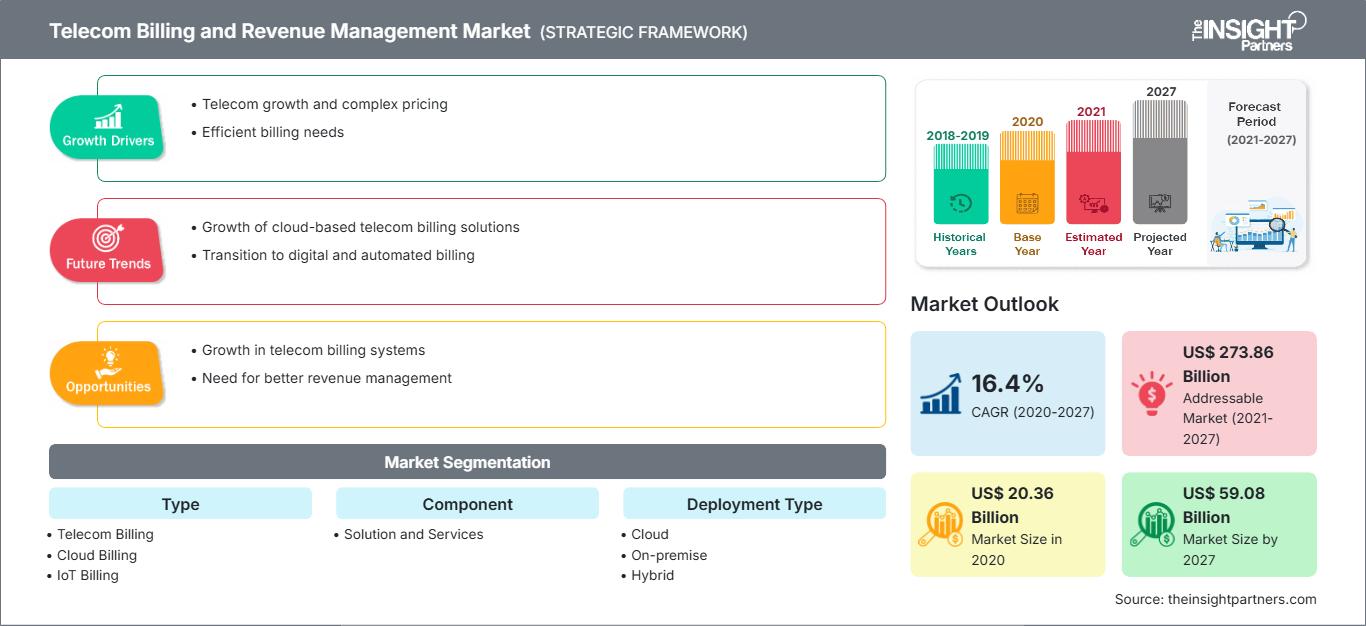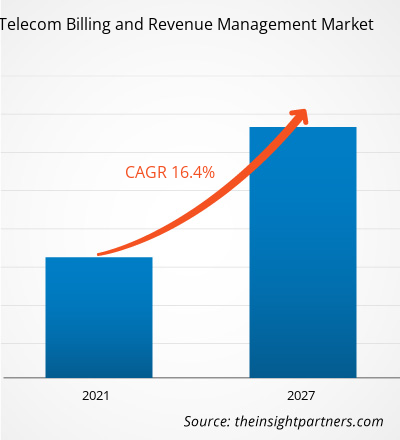The telecom billing and revenue management market expected to grow from US$ 20,362.5 million in 2020 to US$ 59,075.4 million by 2027; it is estimated to grow at a CAGR of 16.4% from 2020 to 2027.
Improving needs for innovative billing and revenue management solutions and services is attributing to the growth of the market. The constant urge and requirement for providing rich communication services and improved high-quality customer experiences is cajoling telecom billing and revenue management solution and services providers to further develop such solutions and services, which are compatible and at-par for full filling the dynamic requirement and demand of end-users with improved scalability, flexibility, and functionality. Efficient and flexible billing and revenue management solutions help the CSP’s to monetize the data and service usage further, providing company with improved real-time data analytical capabilities and efficiency to channelize their revenue streams by further providing customized solutions. It also helps CSPs to efficiently manage the growing subscriber’s billing and charging processes through an effective single platform.
Further, it helps companies and provides them the confidence to roll out new customized offers, revenue-generating services, and charging policies in a short period with improved efficiency, and also to monetize their infrastructural investments while enhancing customer and revenue management. CSP’s are continually upgrading their legacy systems by adding platforms that will help in servicing enhanced subscriber base and migrating towards cloud-based solutions and services such as SaaS, which will help them to lower down the CAPEX while optimizing OPEX. Additionally, increasing spending trends and requirements on solutions such as BSS/OSS is also accelerating the growth of competitive global telecom billing and revenue management market.
Impact of COVID-19 Pandemic on Telecom Billing and Revenue Management Market
The COVID-19 crisis had a positive impact on the growth of some sectors such as IT and telecommunications. The demand for digital services especially has grown at a high rate in past few months. Nevertheless, the decrease in business activities such as partnerships to increase the adoption of telecom billing and revenue management solutions in various countries is anticipated to impact the telecom billing and revenue management provider’s expansion growth negatively. Hence, there will be a mixed impact due to which the growth will drop a little in 2020 and 2021.
Customize This Report To Suit Your Requirement
You will get customization on any report - free of charge - including parts of this report, or country-level analysis, Excel Data pack, as well as avail great offers and discounts for start-ups & universities
Telecom Billing and Revenue Management Market: Strategic Insights

-
Get Top Key Market Trends of this report.This FREE sample will include data analysis, ranging from market trends to estimates and forecasts.
Market Insights–Telecom Billing and Revenue Management Market
Increasing Preference towards Cloud-Based Solutions and Services
Telecom operators and CSP’s worldwide are facing complexity in managing systems, scaling network infrastructure and catering to ever increasing consumer base. Attaining high operational efficiency along with improved revenue management and collection is one of the top priorities and requirement for the telecom operators and CSP’s. Efficient cloud-based billing solutions provides telecom operators and CSP’s ease to effectively monitor subscriber service usage according to the service plans and charge accordingly. It helps CSP’s to manage their payments, accounts and help them to build, plan and optimize their networks, while supporting companies to manage high number of simultaneous transactions and customer requests.
One of the biggest advantage that cloud-based solutions and services model such as SaaS provide to telecom operators and CSP’s is low initial investment or capital cost. It helps companies to reduce infrastructural investment and integration efforts, providing them facilities such as pay-as-you-go model which also helps companies to try out new solutions with low risk. Also, services models like SaaS provide telecom operators and CSP’s the ability to quickly deploy and support new and existing services, thereby helping companies to enter into new markets venues more quickly and economically with greater flexibility.
Component-Based Insights
Based on component, the telecom billing and revenue management market is segmented into solution and services. The solutions segments held the largest market share in 2019.
Players operating in the telecom billing and revenue management market are mainly focused on the development of advanced and efficient products.
- In 2020, TDC, a Danish-based operator, has chosen Comarch SA in order to offer its BSS solutions. The company offered TDC its customer order management, convergent billing system, and application integration framework.
- In 2020, Telecom Fiji Limited, provider telephony services, collaborated with Oracle Communications in order to update customer engagement and speed delivery of products and services. The company will deploy Oracle’s billing and revenue management as part of the Oracle Digital Experience for Communications suite, to allow a digital customer experience.
The telecom billing and revenue management market has been segmented as follows:
Telecom Billing and Revenue Management Market – by Component
- Solution
- Billing Management
- Account Management
- Others
- Services
- Professional Services
- Managed services
Telecom Billing and Revenue Management Market – by Type
- Telecom Billing
- Cloud Billing
- IoT Billing
Telecom Billing and Revenue Management Market – by Deployment Type
- On-Premises
- Cloud-Based
- Hybrid
Telecom Billing and Revenue Management Market – by Geography
-
North America
- US
- Canada
- Mexico
-
Europe
- France
- Germany
- Italy
- Spain
- U.K
- Rest of Europe
-
Asia Pacific (APAC)
- Japan
- China
- Australia
- India
- Rest of APAC
-
Middle East and Africa (MEA)
- UAE
- Dubai
- Saudi Arabia
- Qatar
- South Africa
- Ethiopia
- Rwanda
- Kenya
- Cote d’Ivorie
- Ghana
- Nigeria
- Egypt
- Morocco
- Tunisia
- Turkey
- Rest of MEA
-
South America (SAM)
- Brazil
- Argentina
- Chile
- Peru
- Colombia
- Rest of SAM
The regional trends and factors influencing the Telecom Billing and Revenue Management Market throughout the forecast period have been thoroughly explained by the analysts at The Insight Partners. This section also discusses Telecom Billing and Revenue Management Market segments and geography across North America, Europe, Asia Pacific, Middle East and Africa, and South and Central America.
Telecom Billing and Revenue Management Market Report Scope
| Report Attribute | Details |
|---|---|
| Market size in 2020 | US$ 20.36 Billion |
| Market Size by 2027 | US$ 59.08 Billion |
| Global CAGR (2020 - 2027) | 16.4% |
| Historical Data | 2018-2019 |
| Forecast period | 2021-2027 |
| Segments Covered |
By Type
|
| Regions and Countries Covered |
North America
|
| Market leaders and key company profiles |
|
Telecom Billing and Revenue Management Market Players Density: Understanding Its Impact on Business Dynamics
The Telecom Billing and Revenue Management Market is growing rapidly, driven by increasing end-user demand due to factors such as evolving consumer preferences, technological advancements, and greater awareness of the product's benefits. As demand rises, businesses are expanding their offerings, innovating to meet consumer needs, and capitalizing on emerging trends, which further fuels market growth.

- Get the Telecom Billing and Revenue Management Market top key players overview
Telecom Billing and Revenue Management Market – Company Profiles
- Accenture PLC
- Alcatel-Lucent S.A.
- Amdocs, Inc.
- Cerillion PLC
- CSG Systems International, Inc.
- Ericsson
- goTransverse International, Inc.
- Hewlett-Packard Development Company L.P.
- Huawei Technologies Co., Ltd.
- NEC Corporation
- Oracle Corporation
- Redknee, Inc.
- SAP SE
- XURA
- Panamax
- stl.tech
- Comviva
- Enghouse Networks
- Fiserv, Inc.
- Vcare Corporation
- Mphasis
- Agility CIS
- ESKADENIA
- Netcracker
- Historical Analysis (2 Years), Base Year, Forecast (7 Years) with CAGR
- PEST and SWOT Analysis
- Market Size Value / Volume - Global, Regional, Country
- Industry and Competitive Landscape
- Excel Dataset
Recent Reports
Related Reports
Testimonials
Reason to Buy
- Informed Decision-Making
- Understanding Market Dynamics
- Competitive Analysis
- Identifying Emerging Markets
- Customer Insights
- Market Forecasts
- Risk Mitigation
- Boosting Operational Efficiency
- Strategic Planning
- Investment Justification
- Tracking Industry Innovations
- Aligning with Regulatory Trends





















 Get Free Sample For
Get Free Sample For